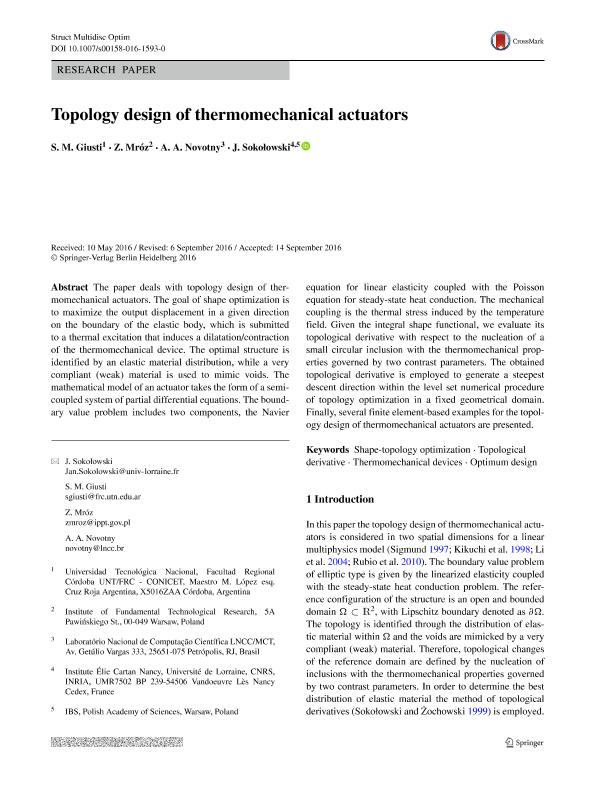Mostrar el registro sencillo del ítem
dc.contributor.author
Giusti, Sebastian Miguel

dc.contributor.author
Mróz, Z.
dc.contributor.author
Novotny, Andrea Natalia

dc.contributor.author
Sokolowski, J.
dc.date.available
2019-04-24T19:11:17Z
dc.date.issued
2017-05
dc.identifier.citation
Giusti, Sebastian Miguel; Mróz, Z.; Novotny, Andrea Natalia; Sokolowski, J.; Topology design of thermomechanical actuators; Springer; Structural and Multidisciplinary Optimization; 55; 5; 5-2017; 1575-1587
dc.identifier.issn
1615-147X
dc.identifier.uri
http://hdl.handle.net/11336/74948
dc.description.abstract
The paper deals with topology design of thermomechanical actuators. The goal of shape optimization is to maximize the output displacement in a given direction on the boundary of the elastic body, which is submitted to a thermal excitation that induces a dilatation/contraction of the thermomechanical device. The optimal structure is identified by an elastic material distribution, while a very compliant (weak) material is used to mimic voids. The mathematical model of an actuator takes the form of a semi-coupled system of partial differential equations. The boundary value problem includes two components, the Navier equation for linear elasticity coupled with the Poisson equation for steady-state heat conduction. The mechanical coupling is the thermal stress induced by the temperature field. Given the integral shape functional, we evaluate its topological derivative with respect to the nucleation of a small circular inclusion with the thermomechanical properties governed by two contrast parameters. The obtained topological derivative is employed to generate a steepest descent direction within the level set numerical procedure of topology optimization in a fixed geometrical domain. Finally, several finite element-based examples for the topology design of thermomechanical actuators are presented.
dc.format
application/pdf
dc.language.iso
eng
dc.publisher
Springer

dc.rights
info:eu-repo/semantics/openAccess
dc.rights.uri
https://creativecommons.org/licenses/by-nc-sa/2.5/ar/
dc.subject
Optimum Design
dc.subject
Shape-Topology Optimization
dc.subject
Thermomechanical Devices
dc.subject
Topological Derivative
dc.subject.classification
Otras Ingenierías y Tecnologías

dc.subject.classification
Otras Ingenierías y Tecnologías

dc.subject.classification
INGENIERÍAS Y TECNOLOGÍAS

dc.title
Topology design of thermomechanical actuators
dc.type
info:eu-repo/semantics/article
dc.type
info:ar-repo/semantics/artículo
dc.type
info:eu-repo/semantics/publishedVersion
dc.date.updated
2019-04-16T20:40:06Z
dc.identifier.eissn
1615-1488
dc.journal.volume
55
dc.journal.number
5
dc.journal.pagination
1575-1587
dc.journal.pais
Alemania

dc.description.fil
Fil: Giusti, Sebastian Miguel. Universidad Tecnológica Nacional. Facultad Regional Córdoba. Departamento de Ingeniería Civil; Argentina. Consejo Nacional de Investigaciones Científicas y Técnicas. Centro Científico Tecnológico Conicet - Córdoba; Argentina
dc.description.fil
Fil: Mróz, Z.. Institute Of Fundamental Technological Research Of The Polish Academy Of Sciences; Polonia
dc.description.fil
Fil: Novotny, Andrea Natalia. Laboratorio Nacional de Computacao Cientifica; Brasil
dc.description.fil
Fil: Sokolowski, J.. Institute Of Fundamental Technological Research Of The Polish Academy Of Sciences; Polonia. Université de Lorraine; Francia
dc.journal.title
Structural and Multidisciplinary Optimization

dc.relation.alternativeid
info:eu-repo/semantics/altIdentifier/doi/http://dx.doi.org/10.1007/s00158-016-1593-0
dc.relation.alternativeid
info:eu-repo/semantics/altIdentifier/url/https://link.springer.com/article/10.1007%2Fs00158-016-1593-0
Archivos asociados
